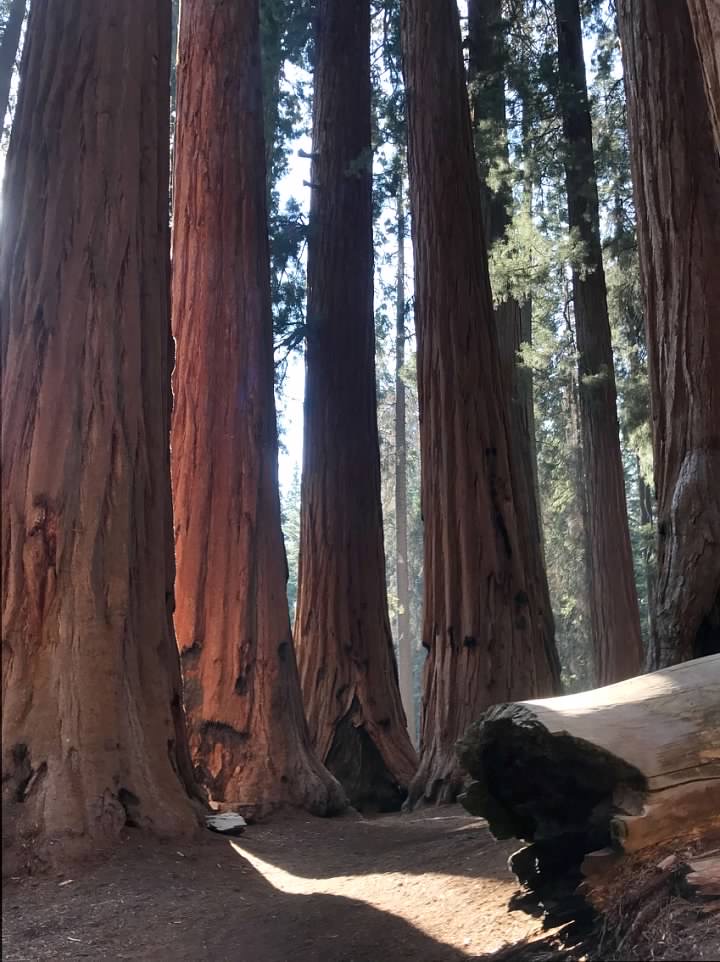Overview
Sequoia National Park is America’s second national park! It was established on September 25, 1890 to preserve a large section of the Sierra Nevada. It contains the highest point in the contiguous 48 states – Mount Whitney – and the world’s largest tree – General Sherman. It is connected to nearby Kings Canyon National Park by the General’s Highway, and the two parks are administered together.

Giant Forest
The Giant Forest is home to five of the top ten largest tress on Earth, including the largest, General Sherman. It is the most accessible sequoia grove in the world located on the General’s Highway with more than 40 miles of hiking trails. The Congress Trail is one of our favorite trails in the entire national park system! It is a paved 2.7 miles that gently slopes through the Giant Forest. Along the trail, hikers meet the President, the Senate, and the House. Stopping to enjoy the grandeur of the groupings of trees in the Senate and House was one of favorite moments in the park.



General Sherman
The largest tree by volume in the world – General Sherman is 275 feet tall and 103 feet around. The General is about a half mile from the parking area on a paved accessible trail. Naturalist James Wolverton named the tree after General William Tecumseh Sherman, who he served under in the U.S. Civil War.

Giant Forest Museum
The Giant Forest Museum is an important location in the park. The museum tells about the Giant Forest and the life cycle of sequoias; it is also the departure point for shuttles to other parts of the park. One of our favorite trees, the Sentinel, is located near the museum’s front door.

Moro Rock
Located in the center of the park, Moro Rock is a 6,725 foot granite peak. In 1931, the National Park Service cut a staircase into the granite, so visitors could more easily climb to the top. On a clear day, hikers can see Great Western Divide from the summit. Unfortunately on our visit, the view was obstructed by smoke from a wildfire on the other side of the park. In the summer, free shuttles from the Giant Forest Museum run to Moro Rock. On weekends, the road to Moro Rock is closed to private vehicles and the shuttle is the only way to get to Moro Rock.



Tunnel Log
In 1937, an unnamed Sequoia fell across the Crescent Meadow Road in Giant Forest. Rather than remove the entire fallen tree, the Park Service cut a 17 foot wide, 8 foot high tunnel through the fallen tree. The free park shuttle makes a stop here, so visitors can get out and explore the area. The Tunnel Log is not to be confused for the famous Wawona Tree that was located 100 miles north in Yosemite’s Mariposa Grove. In 1881, a tunnel was cut through the still living Wawona Tree, but the tree eventually died.

Crescent Meadow
John Muir called Crescent Meadow the “Gem of the Sierra Nevada.” It is a beautiful small meadow lined with sequoias. The High Sierra Trail that leads to Mount Whitney begins at Crescent Meadow. We hiked the Tharp’s Log Trail from Crescent Meadow.

Tharp’s Log Trail
Tharp’s Log is about a mile from Crescent Meadow. The log is named for Hale Tharp, the first non-Native American to enter the Giant Forest. Tharp used the log as shelter. John Muir called the log a “noble den.”

From Tharp’s Log we made a loop along the Log Meadow Trail to the Chimney Tree – a sequoia that burned in 1914. Its stump resembles a hollow chimney.

We loved hiking in this part of the park! The trails are well maintained and perfect for a family adventure.


Hospital Rock
Hospital Rock is the site of a Potwisha Native American settlement. Hale Tharp named the spot Hospital Rock after the Native Americans helped heal Tharp’s brother-in-law’s injured leg in 1860. Today, pictographs can still be found on the rock and around the area.

We enjoyed the scenic drive along the Kaweah River on the way out of the park toward Visalia.

Check out our post about nearby Kings Canyon National Park!
Click here for more Land of Liberty Explorers!
Like this page? Be sure to pin it!



